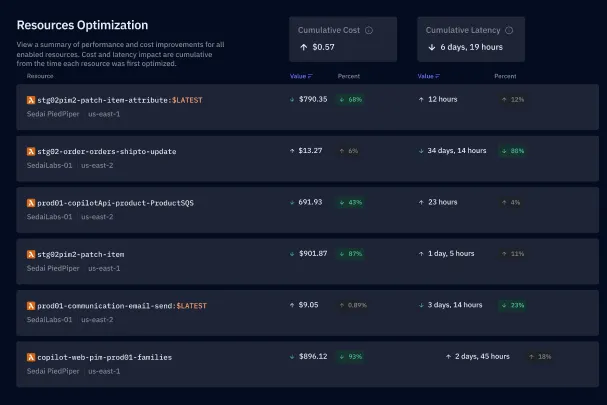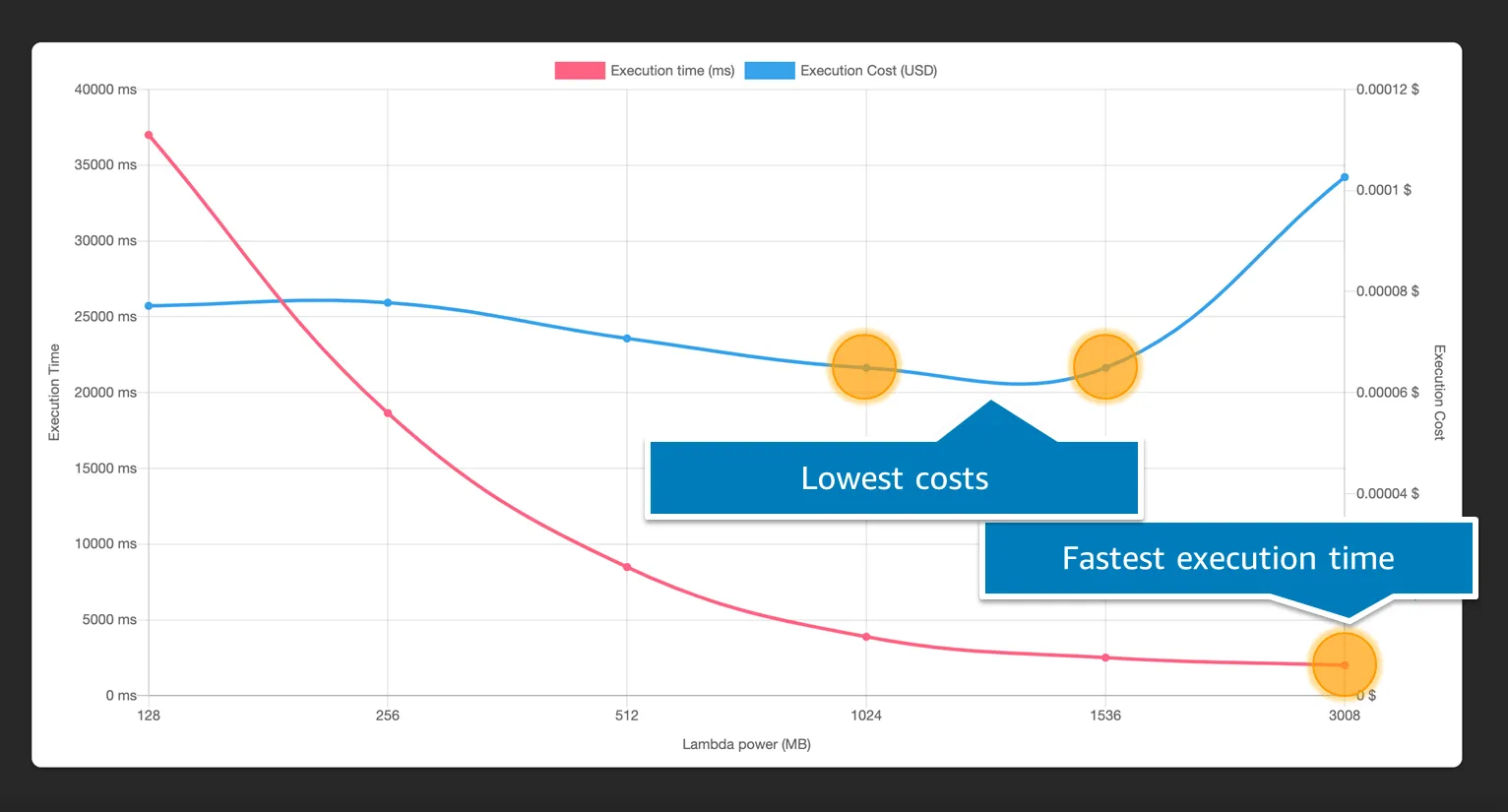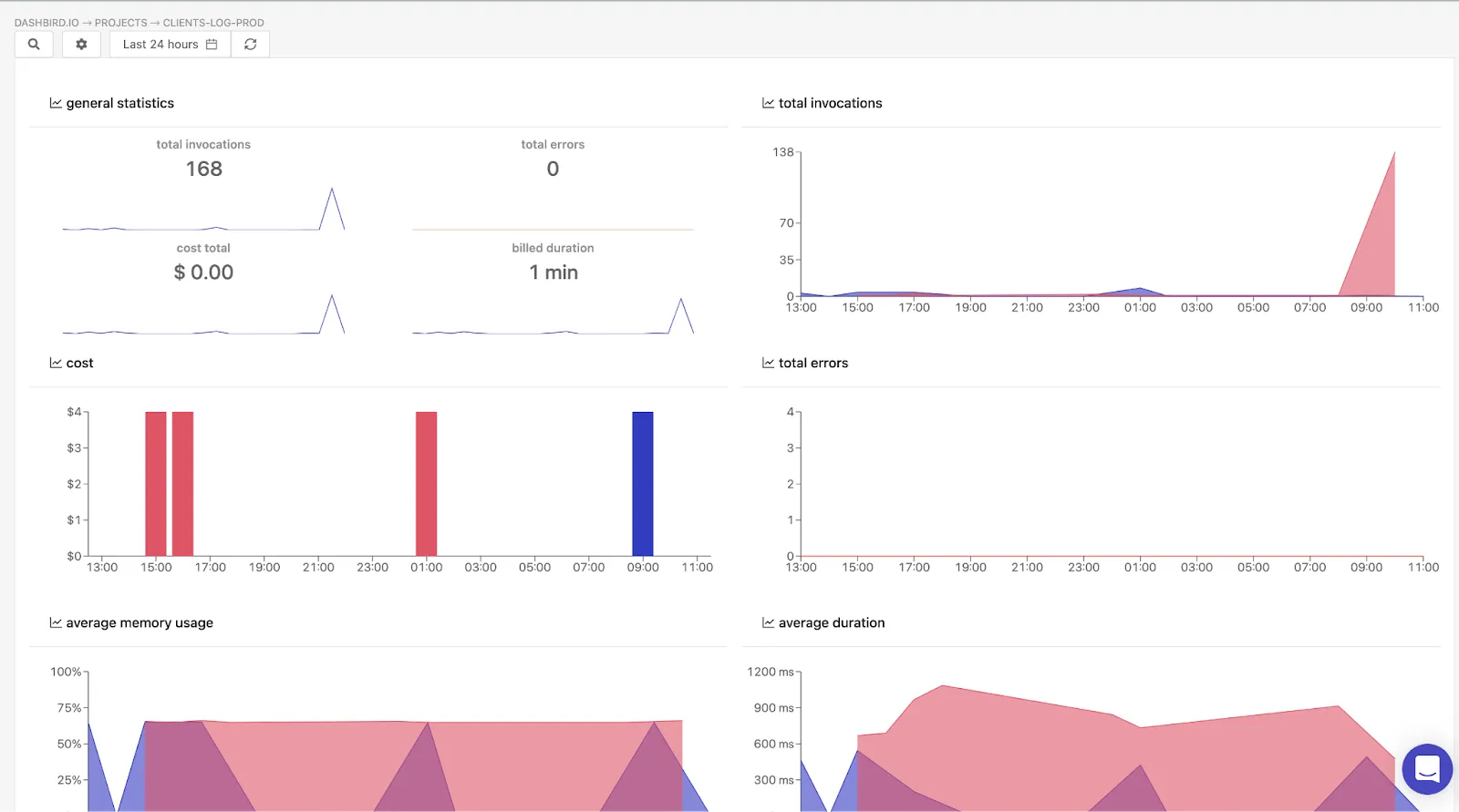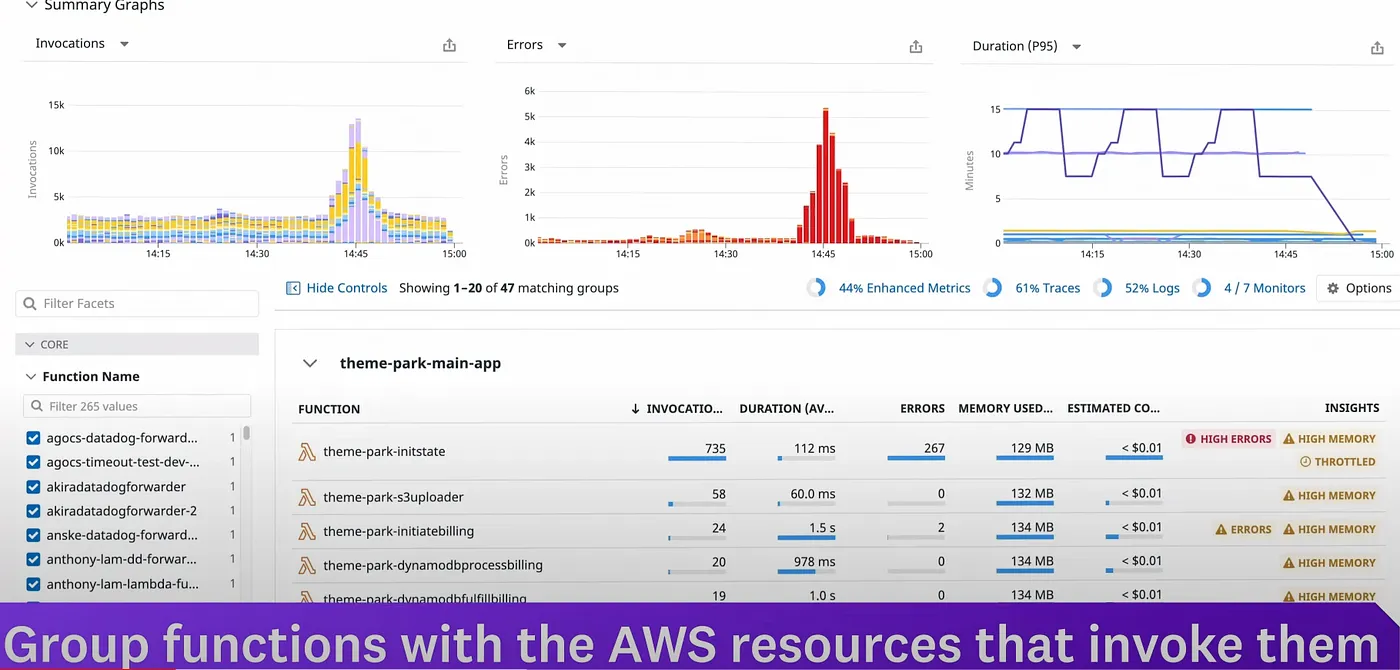Unlock the Full Value of FinOps
By enabling safe, continuous optimization under clear policies and guardrails

November 21, 2025
March 21, 2025
November 21, 2025
March 21, 2025
As an engineer, you're likely familiar with AWS Lambda, a powerful serverless computing service that scales with your business needs. However, even Lambda functions can face challenges like cold starts or inefficient memory usage, slowing down your processes and impacting performance.
The solution? Using the right AWS Lambda optimization tools and techniques to fine-tune your functions, ensuring peak performance and cost efficiency. General cloud optimization tools often miss Lambda's specific needs. When deciding between general cloud management platforms and specialized AWS Lambda optimization tools, the key factor is focus.
General platforms offer broad oversight and optimization across cloud environments, while specialized tools provide deep, targeted optimization specifically for Lambda workloads, making them ideal for serverless-first organizations.
Read on to understand more about how AWS Lambda optimization tools can help you optimize your cloud resources effectively.
Even with AWS Lambda’s powerful capabilities, optimizing its performance can be challenging. Understanding the problem and where optimizations are needed are crucial for maintaining a responsive, cost-effective, scalable infrastructure.
1. Memory Tuning
Memory allocation in AWS Lambda is a double-edged sword. Allocating too much memory can lead to overprovisioning, unnecessarily driving up costs. Allocating too little memory can result in underutilization, causing performance bottlenecks. Proper memory tuning is essential to balance performance with cost-effectiveness.
2. Cold Start Management
Cold starts occur when a Lambda function is invoked after a period of inactivity, leading to noticeable latency. This can be particularly detrimental in latency-sensitive applications where even slight delays affect user experience. Predicting and mitigating cold starts remains a significant challenge, especially when demand patterns are unpredictable.
3. Concurrency
Managing fluctuating concurrency in Lambda functions can be challenging, especially during unexpected execution spikes. Provisioned concurrency ensures functions are ready to handle demand surges, while reserved concurrency limits simultaneous executions to prevent overload. Using both helps maintain performance and avoid bottlenecks during unpredictable traffic.
The good news is that there are tools available to help optimize AWS Lambda functions. Choosing the right one for your needs can significantly enhance your cloud strategy.
When evaluating tools, consider these key criteria to ensure they align with your requirements.
Considering these criteria, explore the top AWS Lambda optimization tools and solutions to help you achieve your performance, cost, and scalability goals.
As serverless computing continues to gain popularity, AWS Lambda has become a key player, with over 1 million active customers using its capabilities. However, optimization is essential to maximize performance and cost-efficiency.
Here are the top five AWS Lambda optimization tools that can help enhance your serverless applications.
Overview: Offers AI-powered real-time optimization, designed for computing services like AWS Lambda and focused on performance and cost efficiency. Sedai helps businesses reduce cloud costs by up to 30%, improve performance by 75%, and minimize failed customer interactions by 70%.

Overview: Lambda Power Tuning is a process and tool that helps you find the optimal memory allocation for your AWS Lambda functions, balancing performance and cost. It allows you to allocate memory to your functions, and this setting directly impacts both the execution speed and the associated costs.

AWS Compute Optimizer analyzes resource usage across AWS services, including Lambda functions, to provide actionable recommendations to improve cost efficiency and performance. By using machine learning, it offers tailored advice on Lambda memory settings, and scaling configurations to optimize your AWS environment.


Overview:
AWS Lambda Cold Start Annotations is a specialized tool designed to help teams analyze and optimize cold start times in AWS Lambda functions. Cold starts occur when a Lambda function is invoked after being inactive, leading to increased latency. This tool provides deep insights into cold start occurrences, their frequency, and their impact on application performance, enabling teams to mitigate latency issues effectively.

Unique Features:
Example Customers:
Review Themes:
Overview:
Manual tuning is an optimization approach where teams fine-tune AWS Lambda function configurations by adjusting parameters such as memory allocation, concurrency limits, and function execution logic based on real-world performance metrics. This approach provides maximum control over resource allocation and cost optimization but requires significant expertise in AWS Lambda internals.
Unique Features:
Example Customers:
Review Themes:
There are other AWS Lambda optimization tools that can optimize your development process by streamlining workflows, automating tasks, and enhancing efficiency. While they may not directly optimize code, they are crucial in refining your overall project and helping you build and deploy faster.
Check out how these tools can elevate your development efforts.
Overview: The Serverless Framework is a popular open-source tool that simplifies the deployment and management of serverless applications across multiple cloud providers. Designed to streamline the entire serverless development process, it allows developers to define their infrastructure as code using a simple YAML configuration file.
The Serverless Framework is designed to simplify the deployment and management of Lambda functions, making serverless architecture more accessible and efficient.

Overview: Dashbird is a comprehensive monitoring and observability platform designed explicitly for serverless applications. It provides deep insights into AWS Lambda functions and other serverless resources, helping developers and operations teams effectively monitor, troubleshoot, and optimize their serverless workloads.

Overview: Datadog is a leading monitoring and analytics platform that provides full-stack observability for cloud-based applications, including serverless environments like AWS Lambda. It enables developers, operations teams, and security professionals to monitor, troubleshoot, and optimize their applications across a wide range of cloud services and infrastructure.

Manual tuning involves directly adjusting the settings and configurations of AWS Lambda functions to optimize performance, manage costs, and address specific application needs. Unlike automated tools, manual tuning requires in-depth knowledge of your Lambda functions and their interaction with other AWS services. In some cases, manual tuning might prove to be helpful.
Here is a table highlighting the key differences between manual tuning and tool based optimization, showing why the latter might be a better choice for most scenarios.
Just as a well-maintained vehicle gets you to your destination faster and cheaper, the best practices will help you get the most out of your serverless architecture.
Here are some best practices for optimizing AWS Lambda to keep it running at its peak.
Optimizing your AWS Lambda functions in 2025 is like tuning a high-performance engine; every tweak can improve speed and efficiency. Specialized AWS Lambda optimization tools offer precise, targeted optimizations for serverless environments, outperforming general cloud management platforms. They provide deeper insights and more effective performance improvements for Lambda functions.
With AWS Lambda optimization tools in your corner, you're not just maintaining your serverless infrastructure but elevating it to a new level of performance.
Ready to optimize your AWS Lambda like never before? With Sedai, you can reduce costs, boost performance, and eliminate cold starts, all powered by machine learning. Start optimizing today—connect your cloud, let Sedai learn, and watch as it makes real-time improvements for you. Book a demo now!
March 21, 2025
November 21, 2025
As an engineer, you're likely familiar with AWS Lambda, a powerful serverless computing service that scales with your business needs. However, even Lambda functions can face challenges like cold starts or inefficient memory usage, slowing down your processes and impacting performance.
The solution? Using the right AWS Lambda optimization tools and techniques to fine-tune your functions, ensuring peak performance and cost efficiency. General cloud optimization tools often miss Lambda's specific needs. When deciding between general cloud management platforms and specialized AWS Lambda optimization tools, the key factor is focus.
General platforms offer broad oversight and optimization across cloud environments, while specialized tools provide deep, targeted optimization specifically for Lambda workloads, making them ideal for serverless-first organizations.
Read on to understand more about how AWS Lambda optimization tools can help you optimize your cloud resources effectively.
Even with AWS Lambda’s powerful capabilities, optimizing its performance can be challenging. Understanding the problem and where optimizations are needed are crucial for maintaining a responsive, cost-effective, scalable infrastructure.
1. Memory Tuning
Memory allocation in AWS Lambda is a double-edged sword. Allocating too much memory can lead to overprovisioning, unnecessarily driving up costs. Allocating too little memory can result in underutilization, causing performance bottlenecks. Proper memory tuning is essential to balance performance with cost-effectiveness.
2. Cold Start Management
Cold starts occur when a Lambda function is invoked after a period of inactivity, leading to noticeable latency. This can be particularly detrimental in latency-sensitive applications where even slight delays affect user experience. Predicting and mitigating cold starts remains a significant challenge, especially when demand patterns are unpredictable.
3. Concurrency
Managing fluctuating concurrency in Lambda functions can be challenging, especially during unexpected execution spikes. Provisioned concurrency ensures functions are ready to handle demand surges, while reserved concurrency limits simultaneous executions to prevent overload. Using both helps maintain performance and avoid bottlenecks during unpredictable traffic.
The good news is that there are tools available to help optimize AWS Lambda functions. Choosing the right one for your needs can significantly enhance your cloud strategy.
When evaluating tools, consider these key criteria to ensure they align with your requirements.
Considering these criteria, explore the top AWS Lambda optimization tools and solutions to help you achieve your performance, cost, and scalability goals.
As serverless computing continues to gain popularity, AWS Lambda has become a key player, with over 1 million active customers using its capabilities. However, optimization is essential to maximize performance and cost-efficiency.
Here are the top five AWS Lambda optimization tools that can help enhance your serverless applications.
Overview: Offers AI-powered real-time optimization, designed for computing services like AWS Lambda and focused on performance and cost efficiency. Sedai helps businesses reduce cloud costs by up to 30%, improve performance by 75%, and minimize failed customer interactions by 70%.

Overview: Lambda Power Tuning is a process and tool that helps you find the optimal memory allocation for your AWS Lambda functions, balancing performance and cost. It allows you to allocate memory to your functions, and this setting directly impacts both the execution speed and the associated costs.

AWS Compute Optimizer analyzes resource usage across AWS services, including Lambda functions, to provide actionable recommendations to improve cost efficiency and performance. By using machine learning, it offers tailored advice on Lambda memory settings, and scaling configurations to optimize your AWS environment.


Overview:
AWS Lambda Cold Start Annotations is a specialized tool designed to help teams analyze and optimize cold start times in AWS Lambda functions. Cold starts occur when a Lambda function is invoked after being inactive, leading to increased latency. This tool provides deep insights into cold start occurrences, their frequency, and their impact on application performance, enabling teams to mitigate latency issues effectively.

Unique Features:
Example Customers:
Review Themes:
Overview:
Manual tuning is an optimization approach where teams fine-tune AWS Lambda function configurations by adjusting parameters such as memory allocation, concurrency limits, and function execution logic based on real-world performance metrics. This approach provides maximum control over resource allocation and cost optimization but requires significant expertise in AWS Lambda internals.
Unique Features:
Example Customers:
Review Themes:
There are other AWS Lambda optimization tools that can optimize your development process by streamlining workflows, automating tasks, and enhancing efficiency. While they may not directly optimize code, they are crucial in refining your overall project and helping you build and deploy faster.
Check out how these tools can elevate your development efforts.
Overview: The Serverless Framework is a popular open-source tool that simplifies the deployment and management of serverless applications across multiple cloud providers. Designed to streamline the entire serverless development process, it allows developers to define their infrastructure as code using a simple YAML configuration file.
The Serverless Framework is designed to simplify the deployment and management of Lambda functions, making serverless architecture more accessible and efficient.

Overview: Dashbird is a comprehensive monitoring and observability platform designed explicitly for serverless applications. It provides deep insights into AWS Lambda functions and other serverless resources, helping developers and operations teams effectively monitor, troubleshoot, and optimize their serverless workloads.

Overview: Datadog is a leading monitoring and analytics platform that provides full-stack observability for cloud-based applications, including serverless environments like AWS Lambda. It enables developers, operations teams, and security professionals to monitor, troubleshoot, and optimize their applications across a wide range of cloud services and infrastructure.

Manual tuning involves directly adjusting the settings and configurations of AWS Lambda functions to optimize performance, manage costs, and address specific application needs. Unlike automated tools, manual tuning requires in-depth knowledge of your Lambda functions and their interaction with other AWS services. In some cases, manual tuning might prove to be helpful.
Here is a table highlighting the key differences between manual tuning and tool based optimization, showing why the latter might be a better choice for most scenarios.
Just as a well-maintained vehicle gets you to your destination faster and cheaper, the best practices will help you get the most out of your serverless architecture.
Here are some best practices for optimizing AWS Lambda to keep it running at its peak.
Optimizing your AWS Lambda functions in 2025 is like tuning a high-performance engine; every tweak can improve speed and efficiency. Specialized AWS Lambda optimization tools offer precise, targeted optimizations for serverless environments, outperforming general cloud management platforms. They provide deeper insights and more effective performance improvements for Lambda functions.
With AWS Lambda optimization tools in your corner, you're not just maintaining your serverless infrastructure but elevating it to a new level of performance.
Ready to optimize your AWS Lambda like never before? With Sedai, you can reduce costs, boost performance, and eliminate cold starts, all powered by machine learning. Start optimizing today—connect your cloud, let Sedai learn, and watch as it makes real-time improvements for you. Book a demo now!